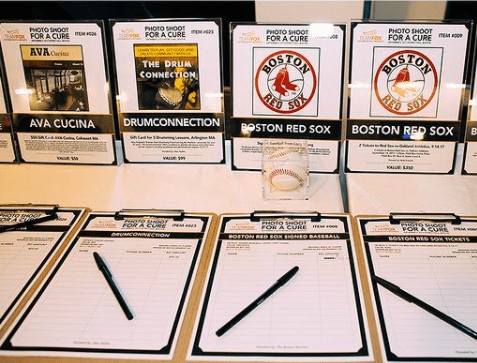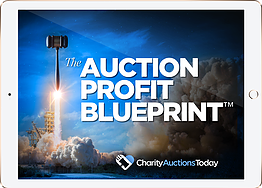DOWNLOAD The Auction Profit Blueprint
The 4 tools BIG organizations use every time to skyrocket auction profits!
The Step-By-Step Guide to stop leaving thousands on the table.
Explore rules for silent auctions and learn how to host one successfully. CharityAuctionsToday offers tips on auction guidelines that can help you stay organized.

Silent auctions are a popular fundraising method. They offer a unique blend of excitement, competition, and the joy of giving.
But what makes a silent auction successful?
The answer lies in understanding and implementing the right silent auction rules. These guidelines ensure a smooth, fair, and enjoyable event for all participants.
This article will provide you with essential guidelines for hosting silent auctions. Whether you’re planning a traditional in-person event or an online auction, these rules will be invaluable.
We’ll cover everything from planning your auction to promoting it, managing the bidding process, and following up after the event. We’ll also delve into the legal and ethical considerations you need to be aware of.
By the end of this guide, you’ll have a comprehensive understanding of the silent auction process. You’ll be equipped to plan and execute a successful event that maximizes fundraising and engages your community.
So, let’s dive into the world of silent auctions and explore the rules that govern them.
Silent auctions are distinct from traditional auctions. In these, participants bid on items without a loud auctioneer. Instead, bidders write down their bids silently.
This format creates a quieter, more relaxed atmosphere. It allows for more personal engagement with the items available. Participants can take time to consider their bids.
Silent auctions offer flexibility. They can be part of a larger event or held entirely online. The key is adhering to established rules and silent auction guidelines to ensure success.
In a silent auction, items are displayed for participants to view. Bidders place their bids on provided sheets or through a digital platform.
Unlike a traditional auction, there’s no need for a fast-paced environment. Participants have the freedom to bid at their leisure. Time constraints are set by the organizers.
This format encourages thoughtful bidding. It enhances the fundraising potential by creating a friendly competitive atmosphere.
Silent auctions are effective fundraising tools. They provide an interactive way for attendees to contribute to a cause.
This method often brings in a diverse audience. People enjoy the competitive yet pressure-free nature of bidding.
Additionally, silent auctions can highlight the generosity of sponsors. They showcase desirable items that attract more participants, increasing funds raised.
Effective planning is crucial for a successful silent auction. Begin by creating a comprehensive plan that outlines every aspect of the event. Consider the venue, or if online, the platform you’ll use.
Determine the overall theme and goals of the auction. This includes deciding the type and number of items you need. With clear planning, you set the stage for success.
Allocate tasks to team members or volunteers. A well-organized team helps ensure smooth execution. Regularly review the plan to make adjustments as necessary.
Setting clear goals is the foundation of a successful auction. Start by defining how much you want to raise. Align this with your broader fundraising objectives.
Budgeting helps keep track of expenses. Identify costs associated with venue, marketing, and technology. A realistic budget will guide your event planning.
Be prepared for unexpected costs. Allocate a portion of your budget for contingencies. This ensures you’re financially ready for surprises.
Select auction items that will appeal to your target audience. Variety is key, so include both high-value and everyday items. Aim for a diverse range to attract different interests.
Reach out to potential donors or sponsors. Local businesses are often willing to donate. Highlight how their contribution supports the cause. Consider both physical items like art, collectibles, and electronics, as well as services and travel packages.
Ensure items are in good condition and properly valued. Fair market valuation helps in setting appropriate starting bids. This also reassures bidders of the item’s worth.
Choose a venue that matches the size and style of your auction. Consider accessibility for your attendees. If planning an online auction, prioritize easy-to-use digital platforms.
The venue or platform should align with your auction goals. It should support essential features like item displays and secure bidding.
For online auctions, platform security is paramount. Ensure bidder data and payment information are protected. This builds trust and encourages participation.

by Anita Jankovic, Unsplash
Establishing clear rules is vital for any silent auction. Rules help ensure fairness and transparency throughout the event. They also protect both organizers and participants from misunderstandings.
Begin by outlining entry requirements for bidders. This could include registering in advance or on the day of the event. Provide information about how and when bidding will occur.
It’s important to communicate minimum bid increments. This helps streamline the bidding process and avoid conflicts. Ensure these increments are clearly visible on bid sheets or digital platforms.
Specify how winners are determined and announce this early on. Knowing what to expect from the rules for silent auctions encourages participation. It also builds trust in your auction’s integrity.
Registration sets the stage for a smooth auction experience. Require bidders to register before participating. This can occur online or in person at the event.
Collecting contact information is essential. It allows for easy communication regarding successful bids or updates. Ensure you respect privacy and comply with any relevant data protection laws.
Clarify participant rules in advance. Inform bidders about the bidding process, payment methods, and item retrieval. Clear communication minimizes confusion during the auction.
Effective item display can influence bidding. Arrange items attractively to catch the eye of participants. Use well-lit areas to enhance visibility and appeal.
Clear item descriptions are crucial. Include details like dimensions, materials, and any unique features. This information helps bidders make informed choices.
Use signage to guide participants. If online, ensure descriptions are easy to access and read. This enhances the overall bidder experience and engagement.
Outline the bidding process clearly to all participants. Whether using bid sheets or digital platforms, instructions must be simple. Clarity ensures smooth and efficient bidding.
Set minimum bids to ensure starting offers are reasonable. This avoids low-ball bids and maximizes fundraising potential. Make sure increments are clearly defined as well.
Monitor the bidding process actively. This helps in resolving any disputes or tie bids promptly. A vigilant approach maintains order and fairness throughout the event.
Encourage competitive bidding by highlighting popular items. This can increase interest and raise more funds. Use announcements or notifications to alert bidders to active items.
Closing the auction is a crucial step. Announce closing times well in advance. This allows participants to plan their final bids accordingly.
Once the auction closes, identify the highest bidders promptly. Transparency here is key to maintaining trust. Clearly communicate how winners are chosen.
Congratulate winners publicly to add excitement. This encourages future participation and engagement. Ensure winners know the next steps for payment and item collection.
Efficient payment collection is essential post-auction. Provide multiple payment options for convenience. This might include cash, checks, or digital payments.
Keep transactions secure, especially online. Prioritize platforms that offer strong privacy measures. Trust in the payment process fosters future participation.
Organize item distribution immediately after payments. Clear instructions about when and where to collect items prevent confusion. It ensures a pleasant experience for winners and wraps up the event smoothly.
Navigating the legal landscape of silent auctions is crucial. Understanding applicable laws protects both organizers and participants. It ensures the event is legitimate and above reproach.
Prioritize transparency in all interactions. Clear rules and honest communication build trust with bidders. Ethical practices enhance credibility and encourage future participation.
Consult a legal advisor if unsure about specific regulations. Professional advice can prevent costly mistakes. Consider this an investment in the auction’s success and integrity.
Local regulations vary significantly and can impact your silent auction. Familiarize yourself with specific requirements in your area to ensure compliance. This may include licenses or permits unique to fundraising events.
Failing to adhere to local laws can lead to penalties. Always research or consult local authorities if in doubt. Taking these steps can prevent legal issues and ensure a hassle-free event.
Tax implications can affect donors and winners. Inform participants about potential tax benefits or liabilities. This awareness fosters informed giving and bidding decisions.
Determine the fair market value for auction items. Accurate valuations are necessary for tax purposes. They help in calculating potential deductions for donors and guide bidders on item worth.

by Eve, Unsplash
Technology has transformed silent auctions. Digital tools streamline planning and execution. They also enhance bidder experience and expand reach.
Online auctions can attract a broader audience. Technology simplifies logistics and reduces manual tasks. Many platforms offer features tailored to fundraising needs.
Data analytics is another powerful tool. It helps assess auction performance and bidder engagement. Insights from these analyses guide future improvement and strategy.
Choosing the right platform is critical for online silent auctions. User-friendly interfaces encourage participation. Platforms that offer seamless navigation enhance bidder satisfaction.
Most silent auction software providers offer built-in features for managing bids and communications. They also allow customizations to align with branding and event themes. This ensures a cohesive experience for participants.
Security is paramount when handling participant data. Trusted auction platforms offer robust privacy measures. Always prioritize platforms with proven track records to safeguard information.
Most platforms will have similar online silent auction rules that will be familiar from your offline experiences.
Mobile bidding is a game-changer in silent auctions. It allows participants to place bids conveniently. This flexibility can boost engagement and raise more funds.
Ensure the mobile platform is intuitive and secure. Ease of use enhances the participant experience. Security measures protect against data breaches and foster trust.
Implement encryption for all transactions. Secure systems prevent unauthorized access and protect bidder privacy. This minimizes risk and instills confidence in your auction’s integrity.
Promotion is vital for a silent auction’s success. Attracting a diverse audience increases bidding activity. A well-crafted marketing plan ensures broad reach and interest.
Start promoting early to build momentum. Use a mix of channels to communicate with potential attendees. Tailor messages to resonate with your target audience.
Leverage existing networks to spread the word. Collaborate with community influencers and partners. Expanding reach through these channels enhances visibility and participation.
Effective marketing strategies drive engagement. Use email campaigns to inform and remind supporters. Personalized messages make participants feel valued and encourage attendance.
Social media offers vast potential for reach. Platforms like Facebook, Instagram, and Twitter are ideal for sharing event details. Visual content captures attention and spurs excitement.
Create engaging and shareable posts. Use eye-catching images and succinct copy. Regular updates on auction highlights keep the event top-of-mind for followers.
Audience engagement fuels bidding enthusiasm. Interactive content keeps participants interested. Host live Q&A sessions or share sneak peeks of auction items.
Develop a theme to create a cohesive experience. Themes add flair and intrigue to your event. They also help streamline marketing communications and event decor.
Provide clear instructions to ease participation. Walkthrough guides or tutorials make bidding accessible. Simple processes reduce barriers and enhance attendee satisfaction.
After the bidding ends, follow-up is key. This phase solidifies relationships. Express gratitude and maintain connections for future events.
Analyze the auction’s outcomes for insights. Examine what worked well and areas needing improvement. Use these insights to refine future strategies and enhance efficacy.
Collect feedback from participants to gauge their satisfaction. This information is invaluable for future planning. It helps align future events with participant expectations and interests.
A heartfelt thank you goes a long way. Acknowledge all who contributed to the auction’s success. Personalized notes express genuine appreciation and build long-term relationships.
Sponsors are vital to your event’s success. Recognize their support publicly and privately. Providing them with impact reports enhances transparency and fosters ongoing partnerships.
Post-event evaluation is crucial. Assess if the auction met fundraising goals. Review participant engagement levels and bidding activity for insights.
Create a feedback loop to collect opinions. Use surveys or informal interviews to gather diverse perspectives. This feedback highlights participant experiences and identifies areas for improvement.
Document lessons learned to inform future planning. This record becomes a blueprint for refining tactics. Continuous improvement ensures each event is more impactful than the last.
Silent auctions offer a unique platform for fundraising and community engagement. By adhering to clear guidelines, organizers can host a successful event that maximizes impact.
Whether in-person or online, a well-executed silent auction fosters positive relationships and advances organizational goals. With careful planning and strategic follow-up, your silent auction can become a memorable and effective event.
The ideal duration for a silent auction often ranges from 90 minutes to three hours. This timeframe maintains bidder interest without causing fatigue.
The specific time can vary depending on the event’s scale and format. Sometimes online silent auctions go for days or weeks.
Yes, silent auctions can be conducted fully online. This approach widens participation across geographical boundaries. Online platforms like ours offer features like automated bid tracking and notifications, enhancing bidder engagement.
Typical items in silent auctions include gift baskets, event tickets, and memorabilia. Experiences like dinner with a local celebrity or a weekend getaway also tend to attract bidders. Remember, variety appeals to a broader audience.
Handling disputes promptly and fairly is crucial. In case of tie bids, refer to your auction rules or consider the first bid placed. Clear communication helps in maintaining trust and transparency among participants.
Selecting between digital and paper bid sheets depends on your auction’s needs. Both options offer unique benefits and come with their challenges. Weigh these factors carefully to choose the most suitable format for your event.
Paper bid sheets provide a tangible, traditional feel. This physical connection can heighten bidder engagement, especially in smaller events. They’re simple to set up, requiring minimal technology and are easy to distribute among items.
Digital bid sheets facilitate streamlined management and real-time updates. They enable remote bidding, expanding participation beyond local attendees. Digital auction platforms often offer integrated features for automatic tracking and notifications.
Using an online bidding platform will make it easier for your guests to mingle and enjoy your event without hovering over items they really want.
Paper bid sheets involve increased manual handling and can get misplaced. They are easier to cheat on: when someone crosses out another bid, for example.
On the other hand, digital systems require reliable internet access and technical support. There might be costs associated with software or platform fees.
Consider factors like audience preference and event size. If your crowd is less tech-savvy, paper may be more effective. Conversely, for larger events with a tech-oriented audience, digital solutions might provide enhanced efficiency and reach.
Creating effective bid sheets can significantly boost the success of your auction. Well-designed sheets encourage participation and ensure seamless bidding processes. Consider the following tips when crafting your bid sheets.
First, ensure clarity by using simple fonts and clear layouts. A clutter-free design makes the sheet easy to read and fill out. Make sure critical information like the item description and starting bid is prominent.
Next, think about including a “Buy Now” option to entice immediate sales. This can boost fundraising totals by tempting bidders who do not want to lose the item. Another effective strategy is to use templates designed for silent auctions, which help in maintaining consistency and professionalism.
A welcoming bid sheet should contain:
Additionally, it is useful to personalize bid sheets with the organization’s logo. This reinforces your branding while promoting the entity behind the event. Customizing sheets to match the event theme can also enhance the attendee experience.
Lastly, gather feedback post-auction to refine your approach for future events. A little analysis goes a long way in improving your silent auctions.
Boosting engagement at your auction is crucial for fundraising success. Begin by allowing space for multiple bids, which pushes rivalry among participants. This setup can lead to higher bidding amounts.
Place the bid sheets in strategic locations. Items should be accessible and visible, drawing participants in effortlessly. Highlighting valuable or unique items also sparks interest and competition.
Create an engaging environment by using stimulating designs on your bid sheets. Such efforts can enhance the aesthetic appeal and foster a lively bidding atmosphere. These tactics not only increase competition but also make the event enjoyable for attendees.
Securing bid sheets is vital to maintain trust and transparency. Use methods like labeling or numbering to prevent them from being misplaced or tampered with. Ensure sheets are monitored regularly throughout the event.
Clear communication of auction terms on the bid sheets fosters transparency. Bidders need confidence that the process is fair. Clearly detailing rules helps in achieving this.
Post-event, verify all bid entries for accuracy before announcing winners. This practice prevents disputes and reinforces a transparent auction experience. Proper handling and organization are key to building and maintaining credibility among participants.
Silent auction bid sheets are invaluable for seamless and successful fundraising events. These sheets organize and document bids while encouraging participation without pressure. By designing well-structured bid sheets, you enhance the auction experience and potential revenue.
Attention to detail in crafting bid sheets can make your auction more engaging and efficient. Elements like clear instructions and thoughtful layout contribute to a positive bidder experience. This attention can increase competition and drive up the amounts bid.
Ultimately, bid sheets are more than just paper. They embody your auction’s professionalism and reliability. Implementing the tips provided ensures that your silent auction reaches its full potential and achieves its goals.
What information should be included on a bid sheet?
A bid sheet should include item details, starting bid, minimum raise, and fields for bidder names and amounts.
How do bid sheets work in a silent auction?
Participants write their bids on bid sheets placed by each item. The highest bid at closing wins.
Can bid sheets be customized?
Yes, they can be tailored to match the event’s theme. Include logos and contact details for a professional look.
What’s the advantage of a “Buy Now” option?
A “Buy Now” option allows bidders to instantly purchase an item at a fixed price, simplifying decisions.
Lorem ipsum dolor sit amet, consectetur adipiscing elit. Ut elit tellus, luctus nec ullamcorper mattis, pulvinar dapibus leo.
DOWNLOAD The Auction Profit Blueprint
The 4 tools BIG organizations use every time to skyrocket auction profits!
The Step-By-Step Guide to stop leaving thousands on the table.

